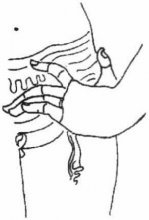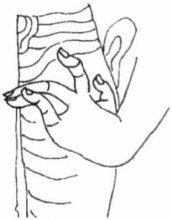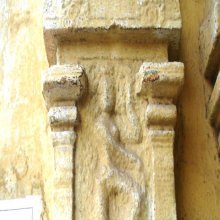Katihasta, Kaṭihasta, Kati-hasta: 3 definitions
Introduction:
Katihasta means something in Hinduism, Sanskrit. If you want to know the exact meaning, history, etymology or English translation of this term then check out the descriptions on this page. Add your comment or reference to a book if you want to contribute to this summary article.
Images (photo gallery)
In Hinduism
Shilpashastra (iconography)
Source: Shodhganga: The significance of the mūla-beras (śilpa)Kaṭihasta (कटिहस्त) or simply Kaṭi refers to “hip” and represents one of the twenty-four gestures with a single hand, as defined according to texts dealing with śilpa (arts and crafs), known as śilpaśāstras.—Accordingly, pratimā-lakṣaṇa (body postures of the icons) is comprised of hand gestures (hasta, mudrā or kai-amaiti), stances/poses (āsanas) and inflexions of the body (bhaṅgas). There are thirty-two types of hands [viz., kaṭihasta] classified into two major groups known as tolirkai (functional and expressive gestures) and elirkai (graceful posture of the hand).
(Description of Kaṭi-hasta): Held at the level of the hip of the image, this mudrā has the thumb raised into the hip and the other fingers spread away from the thumb and held together in line with the palm. The little and the forefinger are away from the hip and arched gracefully while the middle and ring fingers rest on the hip.
Source: Shodhganga: Vaisnava Agamas And Visnu ImagesKaṭihasta (कटिहस्त) refers to one of the various hand-poses (hastas or mudrās) defined in treatises such as the Pāñcarātra, Pādmasaṃhitā and Vaikhānasa-āgamas, extensively dealing with the technical features of temple art, iconography and architecture in Vaishnavism.—Kaṭihasta is generally known as kaṭiga, kaṭistha, kaṭisaṃsthita, kaṭyālambana and kaṭyavalambita. The hand remains bent a Little at the elbow and placed on the upper part of the waist. This gesture is generally found on the lower left hand. Pādmasaṃhitā (Kriyāpāda 20.81b) prescribes, while holding gadā; the hand should be two aṅgulas away from the hip of the icon. According to Nāradīyasaṃhitā, the palm of the hand holding gadā must be to the level of kaṭisūtra. In the absence of gadā, the hand remains touching the hip or it may be kaṭyālambana. The kaṭivastra touching the hip in the movable icon (jaṅgama-arcā) is specially meant for mundane (aihika) results.

Shilpashastra (शिल्पशास्त्र, śilpaśāstra) represents the ancient Indian science (shastra) of creative arts (shilpa) such as sculpture, iconography and painting. Closely related to Vastushastra (architecture), they often share the same literature.
Languages of India and abroad
Kannada-English dictionary
Source: Alar: Kannada-English corpusKaṭihasta (ಕಟಿಹಸ್ತ):—[adjective] standing with a palm placed on the waist.
--- OR ---
Kaṭihasta (ಕಟಿಹಸ್ತ):—[noun] a man standing with one of the palms placed on the waist.
Kannada is a Dravidian language (as opposed to the Indo-European language family) mainly spoken in the southwestern region of India.
See also (Relevant definitions)
Full-text: Kati, Katisamsthita, Katyavalambita, Katistha, Katiga, Urupratishthita, Katyalambana, Subrahmaṇya, Uruhasta, Hasta, Ardhanarishvara, Gada.
Relevant text
Search found 1 books and stories containing Katihasta, Kaṭihasta, Kati-hasta, Kaṭi-hasta; (plurals include: Katihastas, Kaṭihastas, hastas). You can also click to the full overview containing English textual excerpts. Below are direct links for the most relevant articles:
Middle Chola Temples (by S. R. Balasubrahmanyam)
Temples in Tiruppasur < [Chapter IV - Temples of Rajendra I’s Time]


